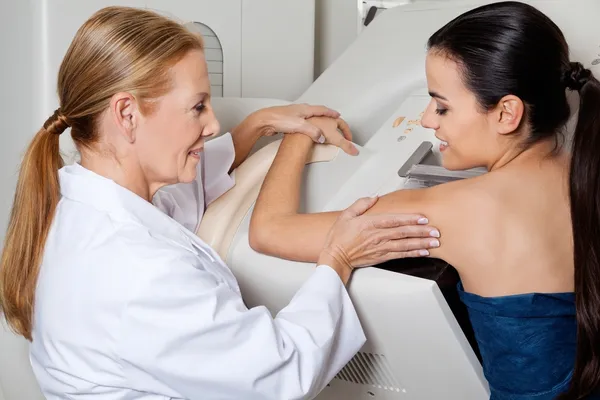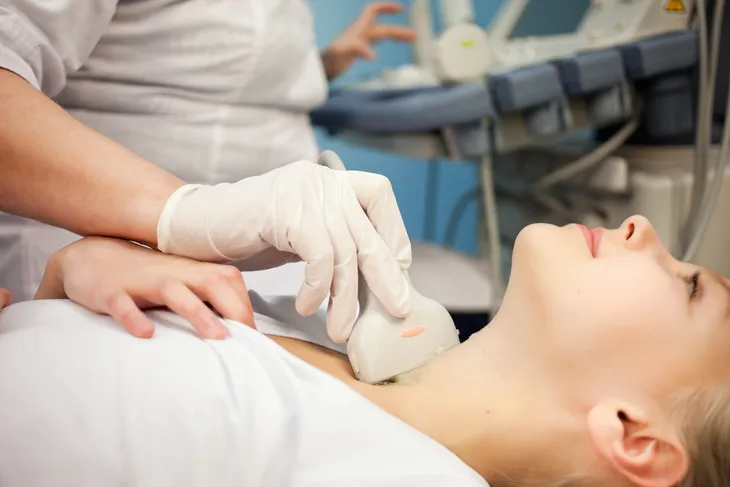Cancer doesn’t pick favorites, but there are certain types that are particular to men or women to look out for. There are certain recommended ages for screening for different types of cancer in women, which a doctor can advise you about.
It’s important to follow screening schedules, because as EveryDay Health points out, lifetime risk of all cancers combined is 1 in 3-for women. “Cancer ranks as the second most frequent cause of death for U.S. women, after heart disease,” it adds. Here are 12 cancer screening tests every woman should consider…
Home Breast Cancer Exam
Along with booking a mammogram, which looks deep into breast tissue to find potential problems, you can also do some self-diagnostics for this form of cancer that overwhelmingly strikes women.
BreastCancer.org lays out a five step method for checking your breasts for signs of cancer. Start by facing a mirror and determining breasts are of their usual size and color; do the same with arms raised; look for signs of fluid discharge from the nipple; feel your breasts while lying down; and then the same while standing or sitting.
Mammogram
Even if you’re doing self-tests to check for lumps in your breasts, a proper test can find a problem even before you notice any changes, explains WebMD.
A mammogram can see breast tissues from several different angles. The source says the American Cancer Society recommends women aged 45 to 54 should be screened once per year, and those aged 55-and older can be screened every two years or continue with once per year. Women also have the choice to start having mammograms at age 40. It is best to talk to your doctor about when you should start because it may also depend on your family history.
BRCA Gene Mutations
EveryDay Health says there’s a genetic test that may be able to determine your risk of breast or ovarian cancers. The BRCA gene test looks at the BRCA1 and BRCA2 genes, and the source notes mutations in these genes have been linked with higher cancer risk in some women.
The test involves collecting blood or saliva samples, it adds. Women with a family history of breast/ovarian and other cancers should consider being screened. According to the National Institute for Health, “…about 72-percent of women who inherit a harmful BRCA1 mutation and about 69-percent of women who inherit a harmful BRCA2 mutation will develop breast cancer by the age of 80.” This is compared to the overall risk of 12-percent for all women says the source.
Cytology-Based Screening (Pap Test)
Also called a Papanicolaou test, this screening method for cervical cancer involves a gentle scraping of the cervix and examining it under a microscope for abnormalities, notes the Canadian Cancer Society.
This test is usually part of a pelvic exam, but you may have to request it specifically. The cancer society assures that while it can be somewhat uncomfortable, it’s not usually painful. Abnormal cells don’t automatically mean there’s a cancer link, but left untreated they may become cancerous, notes the source.
HPV Test
The human papillomavirus (HPV) test is particularly important for women to check for risk of infection, explains WebMD. Much like a pap test, the HPV test collects cells from the cervix for closer examination.
HPV can cause warts and other symptoms, or no symptoms at all, notes the source. A “high risk” type of HPV can show up as abnormal cells on a pap test, and left on their own can “progress to serious abnormalities and may lead to cervical cancer over time,” it adds. The National Cervical Cancer Coalition says women should start with pap tests at age 21, then be co-tested with a pap and HPV screening beginning at age 30.
Transvaginal Ultrasound (TVUS)
Unfortunately, there is no good screening test for ovarian cancer. But if your doctor is concerned because of finding on your pelvic exam or something in your history, they may recommend an ultrasound. This test, along with the CA-125 blood test and a complete pelvic exam, is most commonly used to detect ovarian cancer, notes the American Cancer Society. The TVUS uses sound waves to detect abnormalities in the uterus, fallopian tubes and ovaries – but it won’t be able to tell if a mass is cancerous or benign, it adds.
That’s where the blood test comes in – this looks for CA-125 protein in the blood, which is elevated often in women with ovarian cancer, explains the cancer society. However, there are other conditions that can cause this protein to be high, it adds. New ways to detect ovarian cancers early are being researched.
Spiral CT
This is a lung cancer screening method – and while lung cancer strikes men often, it’s actually the leading cause of cancer-related deaths among women in the U.S., says EveryDay Health.
This CT is an advanced type of X-ray that shows more details, and is especially important for those “who have a history of heavy smoking, and smoke now or have quit within the past 15 years, and are between 55 and 8-years-old,” says the CDC. While this can be an important tool, it also returns false positive tests leading to unnecessary anxiety.
Hysteroscopy with Endometrial Biopsy
The National Cancer Institute says that endometrial sampling (also known as a biopsy) is more effective at reducing mortality rates from endometrial cancer than transvaginal ultrasound. According to Dr. Andrea Eisenberg who is a board certified OB/GYN in the Metro Detroit area says a hysteroscopy with endometrial biopsy is now the standard of care. “The hysteroscopy allows us to see the cavity of the uterus before taking a biopsy and then directing the biopsy more accurately.”
The source explains that up to 85-percent of this cancer of the uterus lining can be detected early from symptoms, and that survival rates “are high.” There can be some discomfort and bleeding from this test, but it’s worth it if you consider the alternative.
Flexible Sigmoidoscopy
This is a test that allows doctors that examine your lower colon area, explains MedicineNet.com. It can find the cause of rectal bleeding and pain, and is also part of screening for colon cancer, it adds.
The American Cancer Society says this form of cancer is the third-leading diagnoses for women and men in the U.S. (it carries a 1 in 24-lifetime risk for women), although death rates are dropping thanks to screening procedures.
Skin Cancer Screening
According to EveryDay Health, skin cancer is the most diagnosed form of cancer in the U.S. Screening for skin cancers basically involves examining moles for abnormalities that can point to basal cell cancer, melanoma, or squamous cell skin cancer, it explains.
The source says there’s a test you can do at home ahead of screening called the ABCDEs of skin cancer, which are: (A)symmetry within 1-mole, an irregular or undefined (B)order, varied (C)olor within the mole including tan, brown, white, or blue, a (D)iameter larger than a pencil eraser, and (E)volving size, shape or color.
Full Colonoscopy
Unlike the sigmoidoscopy that focuses on the lower portion of the colon, a colonoscopy will see the entire colon and rectum using a flexible tube equipped with a small camera.
WebMD says this procedure involves some preparation work a day ahead of time to clean out the colon, and the test itself takes about 30-minutes and is usually painless (a numbing medication will be given). It’s designed to look for growths called polyps in the colon so they can be closely examined for signs of cancer.
A colonoscopy is recommended at age 50 and if negative, every 10 years after that.
Thyroid Screening
The American Cancer Society says that most cases of thyroid cancer can be found early, which is a good reason to be screened for them. The thyroid is a butterfly-shaped gland in the neck that is responsible for a wide range of functions including regulation of nerve functions.
While there are no official screening tests for thyroid cancer, you can routinely check for any lumps or growths in your throat area two times a year, notes the source. A doctor may also find them during a routine checkup, it adds. In other cases, an ultrasound to check for another health problem can uncover early thyroid cancer, says the source. Thyroid cancers are more common in women than men.















